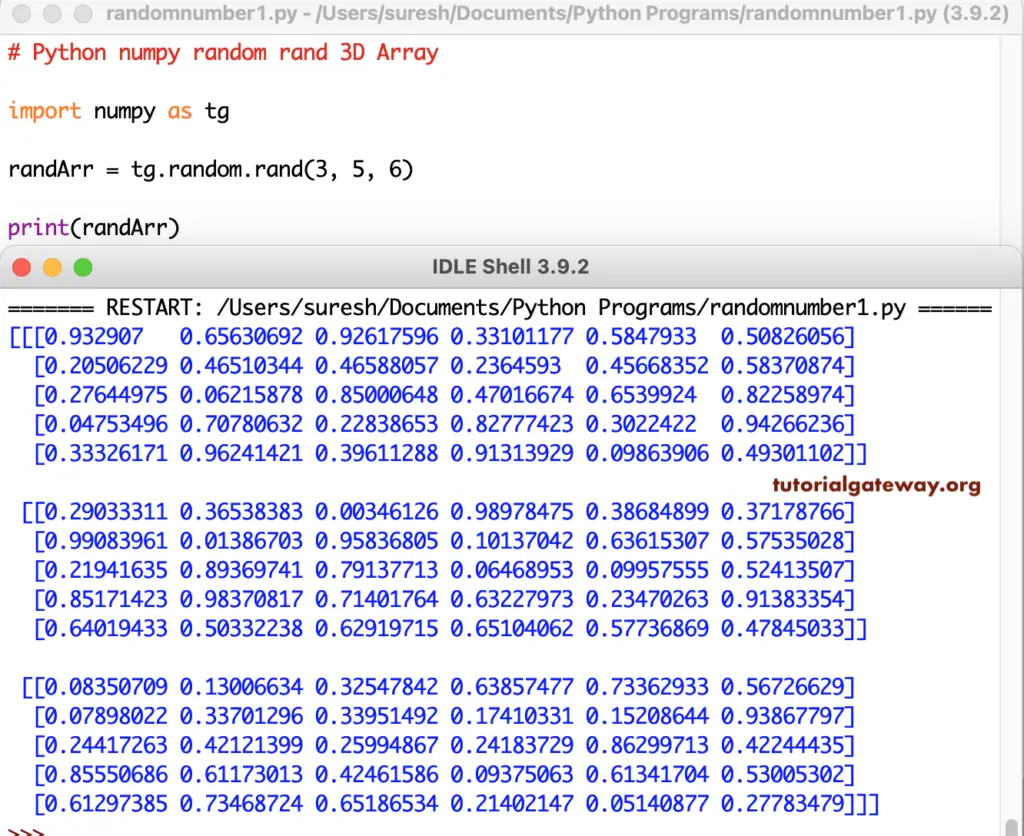

Hope the above examples have cleared your understanding on how to apply it.Įven,Further, if you have any queries then you can contact us for getting more help. The numpy random choice method is able to generate both a random sample that is a uniform or non-uniform sample. Output Generate a random Uniform Sample using 1D Array Conclusion
#NUMPY RANDOM CODE#
And then use the NumPy random choice method to generate a sample.Įxecute the below lines of code to generate it. In this example first I will create a sample array. Output Generate a random Non-Uniform Sample with unique values in the range Example 3: Random sample from 1D Numpy arrayįirstly, Now let’s generate a random sample from the 1D Numpy array. If you want to get only unique elements then you have to use the replace argument.
#NUMPY RANDOM GENERATOR#
This Generator will allow us to generate. You can see it in the figure again, the duplicates elements have been included. The first thing we need to do to generate random numbers in Python with numpy is to initialize a Random Generator. using np.random.rand and np.random.randint we can build random matrix. Output Generate a random Non-Uniform Sample within the range This is a convenience function for users porting code from Matlab, and wraps randomsample. Create almost every kind of matrix with random elements in it using NumPy library. Secondly, Let p is the list of probabilities of each element.

And if you generate the sample using it then random.choice() method, then it includes elements using it. The sample will be created according to it. Here each element has some probabilities. The above case was generating a uniform random sample. Syntax : (lam1.0, sizeNone) Return : Return the random samples as numpy array. Example 2: Non -Uniform random Sample within the range With the help of () method, we can get the random samples from poisson distribution and return the random samples by using this method. You can see that all the generated elements are unique. Output Generate a random Sample with unique values in the range

It generates unique elements within the range.Įxecute the below lines of code. How you can avoid it? You can do so by using the replace argument. The five elements have been generated within the range. Output Generate a random Sample from within the range Then define the number of elements you want to generate. Here You have to input a single value in a parameter. You can generate an array within a range using the random choice() method. p The probabilities of each element in the array to generate.Įxamples of Numpy Random Choice Method Example 1: Uniform random Sample within the range The Default is true and is with replacement. replace It Allows you for generating unique elements. size The number of elements you want to generate. (a, size=None, replace=True, p=None)Īn explanation of the parameters is below. Syntax of the Numpy Random Choice Methodīefore going to the example part, let’s know the syntax of the function. In this entire tutorial, I will discuss it. There is a Numpy random choice method that creates a random sample array from the given 1D NumPy array. In fact, It creates an array that performs calculations very fast. Example Generate a 1-D array containing 5 random integers from 0 to 100: from numpy import random xrandom. Integers The randint () method takes a size parameter where you can specify the shape of an array. show() function has been used to display the chart.Numpy has many useful functions that allow you to do mathematical calculations over an array efficiently. numpy.random is a sub-package of NumPy for working with random numbers and is somewhat similar to the Python standard library random but works with NumPys. In NumPy we work with arrays, and you can use the two methods from the above examples to make random arrays. Next, the plot() function of matplotlib.pyplot has been used to draw the plots of the chart. The values of the y-axis have been generated using arange() function. Here, the values of the x-axis have been generated using random() and sort() functions. The following example shows the way to generate the plots of a chart using the random() function. According to the following output, the total number of True values is 4.Įxample-6: Use of random() function for plotting The different outputs will be generated at different times for random numbers. The following similar output will appear after executing the script. Print ( " \nTotal numbers of head are", np. Print ( "The values of head array are: \n", heads ) # Create the coin flips array based on array values


 0 kommentar(er)
0 kommentar(er)
